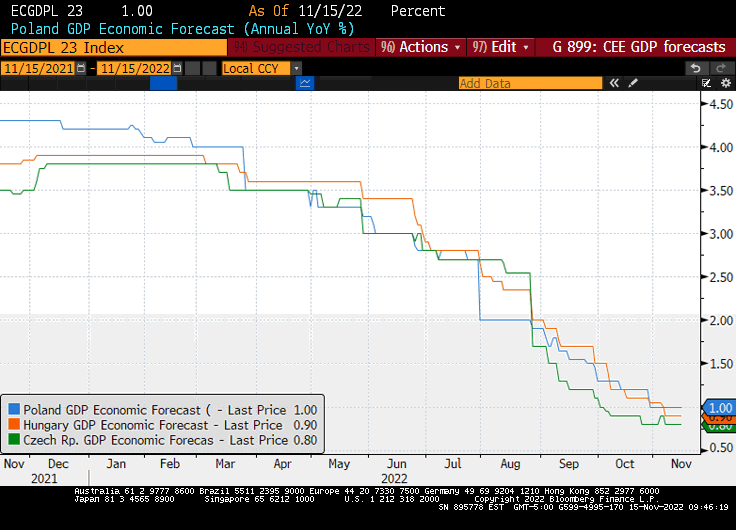EM Growth – The Big Freeze?
November 15, 2022
Read Time 2 MIN
China Slowdown
The growth cliff narrative refuses to go away, and this includes independent global growth drivers, such as China. China’s domestic activity indicators were softer than expected in October – all of them: consumption/retail sales, industrial production, and investments. Property investments and residential property sales contracted further (a lot). The fact that authorities decided to ease some COVID restrictions and introduce additional measures to support the housing sector suggests that negative activity signals were visible well before the official numbers were released. With this in mind, we are leaving today’s backward-looking data behind and shift our attention to the new measures’ impact on the real economy (which might already be visible in the next batch of the activity surveys at the end of the month).
EM Growth Cliff and Rate Cuts
We do get an occasional upside growth surprise here or there – Poland’s Q3 GDP growth was stronger than expected at 3.5% year-on-year. This notwithstanding, domestic activity is clearly moderating on the back of higher inflation (erosion of real disposable income), higher rates, and the impact of the Russia/Ukraine war. The expected shallow recession in Poland’s main trading partner, the Eurozone, is not helping either. The deteriorating external backdrop will be hurting regional peers - Hungary and the Czech Republic - even more, because they are more open economies. Note that both countries posted weaker than expected Q3 GDP numbers (a technical recession in Hungary). The extent of the 2023 growth downgrades in Central Europe is quite astonishing (see chart below), which is why national banks will try to avoid additional rate hikes – despite very high inflation - and start cutting rates at the earliest opportunity.
LATAM Growth Outlook
LATAM’s 2023 growth cliff might be quite sharp as well, with Chile falling into recession, and the Colombian economy expected to slow to 1.9% from 7.3% this year. Colombia’s Q3 GDP print will be released later today, and it will give us a better idea about the speed of slowdown. Colombia’s inflation was still accelerating in October, but the deteriorating growth outlook – together with the slower pace of hikes in the U.S. – cooled the market expectations for additional rate hikes, with the policy rate now expected to peak at 12.4% (vs 13%+ just a couple of weeks ago). Stay tuned!
Chart at a Glance: Central Europe 2023 Growth Downgrades – The End In Sight?

Source: Bloomberg LP.
ECGDPL 23 Index: Bloomberg consensus forecasts for real GDP growth in 2023 for Poland, Hungary and Czech Republic.
Related Topics
Related Insights
February 26, 2024
January 04, 2024
October 27, 2023
PMI – Purchasing Managers’ Index: economic indicators derived from monthly surveys of private sector companies. A reading above 50 indicates expansion, and a reading below 50 indicates contraction; ISM – Institute for Supply Management PMI: ISM releases an index based on more than 400 purchasing and supply managers surveys; both in the manufacturing and non-manufacturing industries; CPI – Consumer Price Index: an index of the variation in prices paid by typical consumers for retail goods and other items; PPI – Producer Price Index: a family of indexes that measures the average change in selling prices received by domestic producers of goods and services over time; PCE inflation – Personal Consumption Expenditures Price Index: one measure of U.S. inflation, tracking the change in prices of goods and services purchased by consumers throughout the economy; MSCI – Morgan Stanley Capital International: an American provider of equity, fixed income, hedge fund stock market indexes, and equity portfolio analysis tools; VIX – CBOE Volatility Index: an index created by the Chicago Board Options Exchange (CBOE), which shows the market's expectation of 30-day volatility. It is constructed using the implied volatilities on S&P 500 index options.; GBI-EM – JP Morgan’s Government Bond Index – Emerging Markets: comprehensive emerging market debt benchmarks that track local currency bonds issued by Emerging market governments; EMBI – JP Morgan’s Emerging Market Bond Index: JP Morgan's index of dollar-denominated sovereign bonds issued by a selection of emerging market countries; EMBIG - JP Morgan’s Emerging Market Bond Index Global: tracks total returns for traded external debt instruments in emerging markets.
The information presented does not involve the rendering of personalized investment, financial, legal, or tax advice. This is not an offer to buy or sell, or a solicitation of any offer to buy or sell any of the securities mentioned herein. Certain statements contained herein may constitute projections, forecasts and other forward looking statements, which do not reflect actual results. Certain information may be provided by third-party sources and, although believed to be reliable, it has not been independently verified and its accuracy or completeness cannot be guaranteed. Any opinions, projections, forecasts, and forward-looking statements presented herein are valid as the date of this communication and are subject to change. The information herein represents the opinion of the author(s), but not necessarily those of VanEck.
Investing in international markets carries risks such as currency fluctuation, regulatory risks, economic and political instability. Emerging markets involve heightened risks related to the same factors as well as increased volatility, lower trading volume, and less liquidity. Emerging markets can have greater custodial and operational risks, and less developed legal and accounting systems than developed markets.
All investing is subject to risk, including the possible loss of the money you invest. As with any investment strategy, there is no guarantee that investment objectives will be met and investors may lose money. Diversification does not ensure a profit or protect against a loss in a declining market. Past performance is no guarantee of future performance.
PMI – Purchasing Managers’ Index: economic indicators derived from monthly surveys of private sector companies. A reading above 50 indicates expansion, and a reading below 50 indicates contraction; ISM – Institute for Supply Management PMI: ISM releases an index based on more than 400 purchasing and supply managers surveys; both in the manufacturing and non-manufacturing industries; CPI – Consumer Price Index: an index of the variation in prices paid by typical consumers for retail goods and other items; PPI – Producer Price Index: a family of indexes that measures the average change in selling prices received by domestic producers of goods and services over time; PCE inflation – Personal Consumption Expenditures Price Index: one measure of U.S. inflation, tracking the change in prices of goods and services purchased by consumers throughout the economy; MSCI – Morgan Stanley Capital International: an American provider of equity, fixed income, hedge fund stock market indexes, and equity portfolio analysis tools; VIX – CBOE Volatility Index: an index created by the Chicago Board Options Exchange (CBOE), which shows the market's expectation of 30-day volatility. It is constructed using the implied volatilities on S&P 500 index options.; GBI-EM – JP Morgan’s Government Bond Index – Emerging Markets: comprehensive emerging market debt benchmarks that track local currency bonds issued by Emerging market governments; EMBI – JP Morgan’s Emerging Market Bond Index: JP Morgan's index of dollar-denominated sovereign bonds issued by a selection of emerging market countries; EMBIG - JP Morgan’s Emerging Market Bond Index Global: tracks total returns for traded external debt instruments in emerging markets.
The information presented does not involve the rendering of personalized investment, financial, legal, or tax advice. This is not an offer to buy or sell, or a solicitation of any offer to buy or sell any of the securities mentioned herein. Certain statements contained herein may constitute projections, forecasts and other forward looking statements, which do not reflect actual results. Certain information may be provided by third-party sources and, although believed to be reliable, it has not been independently verified and its accuracy or completeness cannot be guaranteed. Any opinions, projections, forecasts, and forward-looking statements presented herein are valid as the date of this communication and are subject to change. The information herein represents the opinion of the author(s), but not necessarily those of VanEck.
Investing in international markets carries risks such as currency fluctuation, regulatory risks, economic and political instability. Emerging markets involve heightened risks related to the same factors as well as increased volatility, lower trading volume, and less liquidity. Emerging markets can have greater custodial and operational risks, and less developed legal and accounting systems than developed markets.
All investing is subject to risk, including the possible loss of the money you invest. As with any investment strategy, there is no guarantee that investment objectives will be met and investors may lose money. Diversification does not ensure a profit or protect against a loss in a declining market. Past performance is no guarantee of future performance.

